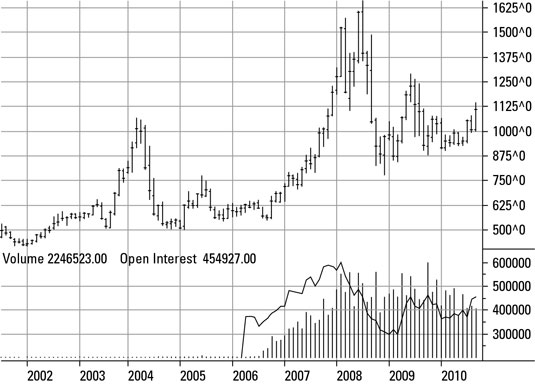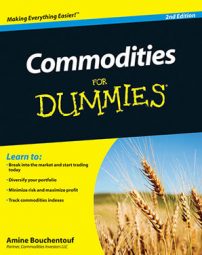Soybeans are used for everything from poultry feedstock to the creation of vegetable oil. There are different soybean extracts you can trade on the commodities markets: soybeans themselves, soybean oil, and soybean meal.
If you’re interested in getting more background information on the soybean industry, check out the following list:
Soybeans
Although most soybeans are used for the extraction of soybean oil (used as vegetable oil for culinary purposes) and soybean meal (used primarily as an agricultural feedstock), whole soybeans are also a tradable commodity. Soybeans are edible, and if you’ve ever gone to a sushi restaurant you might have been offered soybeans as appetizers, under the Japanese name edamame.
The United States dominates the soybean market, accounting for over 50 percent of total global production. Brazil is a distant second, with about 20 percent of the market. The crop in the United States begins in September, and the production of soybeans is cyclical.

The most direct way for you to trade soybeans is through the Chicago Mercantile Exchange (CME) soybean futures contract:
Contract Ticker Symbol: S
Electronic ticker (CME Globex): ZS
Contract size: 5,000 bushels
Underlying commodity: Premium no. 1, no. 2, and no. 3 yellow soybean bushels
Price Fluctuation: $0.0025/bushel ($12.50 per contract)
Trading Hours: 9:30 a.m. to 1:15 p.m. Open Outcry, 6:31 p.m. to 6:00 a.m. Electronic (Chicago Time)
Trading Months: January, March, May, July, August, September, November
Soybean oil
Soybean oil is an extract of soybeans that you and I know as vegetable oil. Soybean oil is the most widely used culinary oil in the United States and around the world, partly because of its healthy, nutritional characteristics. It contains about 85 percent unsaturated fat and very little saturated fat, which makes it appealing to health-conscious consumers.
In addition to its gastronomic uses, soybean oil is becoming an increasingly popular additive in alternative energy sources technology, such as bio-diesel. An increasing number of cars in the United States and abroad, for example, are being outfitted with engines that allow them to convert from regular diesel to soybean oil during operation. Because of their economic fuel mileage and low environmental impact, these soybean oil–enabled cars, known as frybrids, are becoming more popular.
Demand for soybean oil has increased in recent years as demand for these cleaner-burning fuels increases and as the automotive technology is more able to accommodate the usage of such bio-diesels. According to the Commodity Research Bureau (CRB), production of soybean oil increased from an average of 15 Billion Pounds in the mid-1990s to more than 22 Billion Pounds in 2003.
If you want to trade soybean oil, you need to go through the Chicago Board of Trade (CBOT), which offers the standard soybean oil contract. Here is the contract information:
Contract Ticker Symbol: BO
Electronic ticker (CME Globex): ZL
Contract size: 60,000 pounds
Underlying commodity: Premium crude soybean oil
Price Fluctuation: $0.0001/pound ($6.00 per contract)
Trading Hours: 9:30 a.m. to 1:15 p.m. Open Outcry, 6:31 p.m. to 6:00 a.m. Electronic (Chicago Time)
Trading Months: January, March, May, July, August, September, October, December
If you’re wanting more info, take a look at the National Oilseed Processors Association, an industry group,
Soybean meal
Soybean meal, like soybean oil, is an extract of soybeans. Basically, whatever is left after soybean oil is extracted from soybeans can then be converted to soybean meal. Soybean meal is a high protein, high energy-content food that is used primarily as a feedstock for cattle, hogs, and poultry.
To invest in soybean meal, you can trade the soybean meal futures contract on the CME. Here is the information to help you get started trading this contract:
Contract Ticker Symbol: SM
Electronic ticker (CME Globex): ZM
Contract Size: 100 Tons
Underlying commodity: 48% protein soybean meal
Price Fluctuation: $0.10/ton ($10.00 per contract)
Trading Hours: 9:30 a.m. to 1:15 p.m. Open Outcry, 6:31 p.m. to 6:00 a.m. Electronic (Chicago Time)
Trading Months: January, March, May, July, August, September, October, December
You can get more information regarding soybean meal from the Soybean Meal Information Center.

